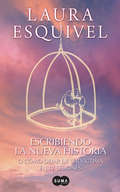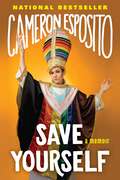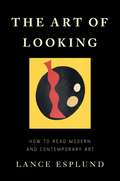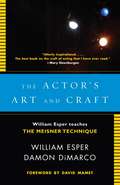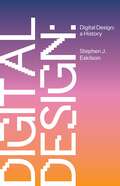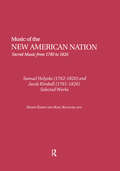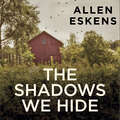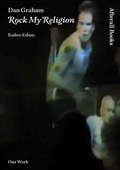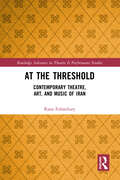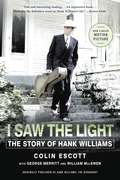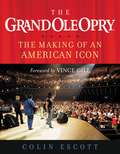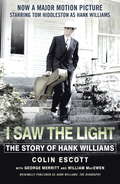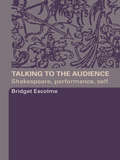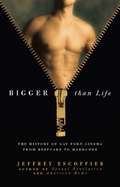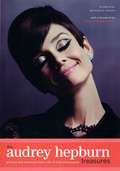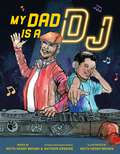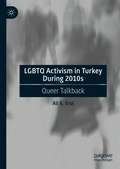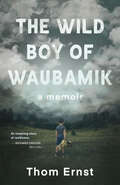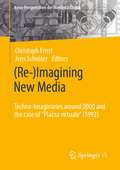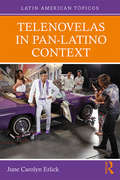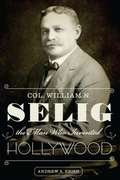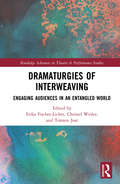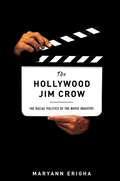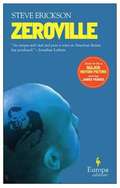- Table View
- List View
Escribiendo la nueva historia
by Laura EsquivelEn este ensayo, Laura Esquivel demuestra cómo el guión cinematográfico es una herramienta para la conciencia que nos permite afrontar nuestro pasado y nuestros temores. De Laura Esquivel, autora del bestseller Como agua para chocolate. Si queremos verdaderamente que la realidad cambie, debemos empezar por un cambio personal. Pero, ¿qué es lo que debemos cambiar? El nuevo libro de Laura Esquivel, Escribiendo la nueva historia o cómo dejar de ser víctima en doce lecciones, es una original propuesta para reflexionar sobre lo que queremos hacer con nuestras vidas, sobre todo cuando perdemos el norte. Escrito con el estilo inconfundible de la autora de Como agua para chocolate, este ensayo nos propone un método para retomar las riendas de la existencia mediante la escritura, gracias, especialmente, a la técnica del guión cinematográfico. Para rediseñar nuestra vida debemos rescribir el guión de la misma. Empezar por los antecedentes, el porqué somos como somos, de qué forma el pasado afecta al resto de nuestras vidas sin que nos demos cuenta. Manejar los miedos y poder superarlos implica que debemos estar listos para cambiar, para ser lo que queríamos ser desde un principio. Porque lo que verdaderamente importa es qué historia contamos, es decir, en qué historia queremos que se convierta nuestra vida y la realidad misma. Lo que ha dicho la crítica: "Este libro es una herramienta para el cambio, para ayudar a dejar los miedos, las culpas, esa idea de que alguien tiene un poder superior al nuestro". -Ericka Montaño Garfias, La Jornada. "Un ensayo acorde con los tiempos de rebelión que corren". -Hoy Extremadura.
Save Yourself: Essays
by Cameron EspositoFrom rising comedy star Cameron Esposito, a memoir that is "as hilarious and honest as she is on the stage," tackling the big issues explored in her comedy, including gender, sexuality and feminism - and how her Catholic childhood prepared her for a career as an outspoken lesbian comedian in ways the Pope could never have imagined (Abby Wambach).Cameron Esposito wanted to be a priest and ended up a stand-up comic. Now she would like to tell the whole queer as hell story. Her story. Not the sidebar to a straight person's rebirth-she doesn't give a makeover or plan a wedding or get a couple back together. This isn't a queer tragedy. She doesn't die at the end of this book, having finally decided to kiss the girl. It's the sexy, honest, bumpy, and triumphant dyke's tale her younger, wasn't-allowed-to-watch-Ellen self needed to read. Because there was a long time when she thought she wouldn't make it. Not as a comic, but as a human. SAVE YOURSELF is full of funny and insightful recollections about everything from coming out (at a Catholic college where sexual orientation wasn't in the nondiscrimination policy) to how joining the circus can help you become a better comic (so much nudity) to accepting yourself for who you are-even if you're, say, a bowl cut-sporting, bespectacled, gender-nonconforming child with an eye patch (which Cameron was). Packed with heart, humor, and cringeworthy stories anyone who has gone through puberty, fallen in love, started a career, or had period sex in Rome can relate to, Cameron's memoir is for that timid, fenced-in kid in all of us-and the fearless stand-up yearning to break free.
The Art of Looking: How to Read Modern and Contemporary Art
by Lance EsplundA veteran art critic helps us make sense of modern and contemporary artThe landscape of contemporary art has changed dramatically during the last hundred years: from Malevich's 1915 painting of a single black square and Duchamp's 1917 signed porcelain urinal to Jackson Pollock's midcentury "drip" paintings; Chris Burden's "Shoot" (1971), in which the artist was voluntarily shot in the arm with a rifle; Urs Fischer's "You" (2007), a giant hole dug in the floor of a New York gallery; and the conceptual and performance art of today's Ai Weiwei and Marina Abramovic. The shifts have left the art-viewing public (understandably) perplexed.In The Art of Looking, renowned art critic Lance Esplund demonstrates that works of modern and contemporary art are not as indecipherable as they might seem. With patience, insight, and wit, Esplund guides us through the last century of art and empowers us to approach and appreciate it with new eyes. Eager to democratize genres that can feel inaccessible, Esplund encourages viewers to trust their own taste, guts, and common sense. The Art of Looking will open the eyes of viewers who think that recent art is obtuse, nonsensical, and irrelevant, as well as the eyes of those who believe that the art of the past has nothing to say to our present.
The Actor's Art and Craft: William Esper Teaches the Meisner Technique
by William Esper Damon DimarcoWilliam Esper, one of the leading acting teachers of our time, explains and extends Sanford Meisner's legendary technique, offering a clear, concrete, step-by-step approach to becoming a truly creative actor.Esper worked closely with Meisner for seventeen years and has spent decades developing his famous program for actor's training. The result is a rigorous system of exercises that builds a solid foundation of acting skills from the ground up, and that is flexible enough to be applied to any challenge an actor faces, from soap operas to Shakespeare. Co-writer Damon DiMarco, a former student of Esper's, spent over a year observing his mentor teaching first-year acting students. In this book he recreates that experience for us, allowing us to see how the progression of exercises works in practice. The Actor's Art and Craft vividly demonstrates that good training does not constrain actors' instincts--it frees them to create characters with truthful and compelling inner lives.From the Trade Paperback edition.
Digital Design: A History
by Stephen EskilsonA groundbreaking history of digital design from the nineteenth century to todayDigital design has emerged as perhaps the most dynamic force in society, occupying a fluid, experimental space where product design intersects with art, film, business, engineering, theater, music, and artificial intelligence. Stephen Eskilson traces the history of digital design from its precursors in the nineteenth century to its technological and cultural ascendency today, providing a multifaceted account of a digital revolution that touches all aspects of our lives.We live in a time when silicon processors, miniaturization, and CAD-enhanced 3D design have transformed the tangible world of cars and coffee makers as well as the screen world on our phones, computers, and game systems. Eskilson provides invaluable historical perspective to help readers better understand how digital design has become such a vibrant feature of the contemporary landscape. He covers topics ranging from graphic and product design to type, web design, architecture, data visualization, and virtual reality. Along the way, he paints compelling portraits of key innovators behind this transformation, from foundational figures such as Marshall McLuhan, Nam June Paik, and April Greiman to those mapping new frontiers, such as Jeanne Gang, Jony Ive, Yugo Nakamura, Neri Oxman, and Jewel Burks Solomon.Bringing together an unprecedented array of sources on digital design, this comprehensive and richly illustrated book reveals how many of the digital practices we think of as cutting-edge actually originated in the analog age and how the history of digital design is as much about our changing relationship to forms as the forms themselves.
Samuel Holyoke: Selected Works (Music of the New American Nation: Sacred Music from 1780 to 1820 #12)
by Harry EskewThis series presents the music of early American composers of sacred music・psalmody, as it was called・in collected critical editions. Each volume has been prepared by a scholar who has studied the musical history of the period and the stylistic qualities of the composer. The purpose of the series is to present the music of important early American composers in accurate editions for both performance and study. This volume presents representative compositions by two American psalmodists, Samuel Holyoke and Jacob Kimball, who were actively engaged in the reform of American psalmody during the 1790s and early 1800s. American compositions were often criticized for two features: their failure to conform to the harmonic norms of European art music and their often vigorous, animated musical style, which was sometimes considered lacking in a reverent spirit appropriate for use in public worship
The Shadows We Hide
by Allen EskensA young reporter must come to terms with his past - and present - while investigating the murder of a man he believes could be his father.Joe Talbert, Jr. has never once met his namesake. Now out of college, a cub reporter for the Associated Press in Minneapolis, he stumbles across a story describing the murder of a man named Joseph Talbert in a small town in southern Minnesota. Full of curiosity about whether this man might be his father, Joe is shocked to find that none of the town's residents have much to say about the dead man - other than that his death was long overdue. Joe discovers that the dead man was a loathsome lowlife who cheated his neighbors, threatened his daughter, and squandered his wife's inheritance after she, too, passed away - an inheritance that may now be Joe's. Mired in uncertainty and plagued by his own devastated relationship with his mother, who is seeking get back into her son's life, Joe must put together the missing pieces of his family history - before his quest for discovery threatens to put him in a grave of his own.(P) 2018 Hachette Audio
Dan Graham: Rock My Religion (One Work)
by Kodwo EshunAn illustrated exploration of a groundbreaking work and its connections to New York's art and music scenes of the 1980s.Dan Graham's Rock My Religion (1982–1984) is a video essay populated by punk and rock performers (Patti Smith, Jim Morrison, Jerry Lee Lewis, and Eddie Cochran) and historical figures (including Ann Lee, founder of the Shakers). It represented a coming together of narrative voice-overs, singing and shouting voices, and jarring sounds and overlaid texts that proposed a historical genealogy of rock music and an ambitious thesis about the origins of North America's popular culture. Because of its passionate embrace of underground music, its low-fi aesthetics, interest in politics, and liberal approach to historiography, the video has become a landmark work in the history of contemporary moving image and art; but it has remained, possibly for the same reasons, one of Graham's least written about works—underappreciated and possibly misunderstood by the critics who otherwise celebrate him. This illustrated study of Graham's groundbreaking work fills that critical gap.Kodwo Eshun examines Rock My Religion not only in terms of contemporary art and Graham's wider body of work but also as part of the broader culture of the time. He explores the relationship between Graham and New York's underground music scene of the 1980s, connecting the artistic methods of the No Wave bands—especially their group dynamics and relationship to the audience—and Rock My Religion's treatment of working class identity and culture.
At the Threshold: Contemporary Theatre, Art, and Music of Iran (Routledge Advances in Theatre & Performance Studies)
by Rana EsfandiaryThis book examines the performance strategies used by contemporary Iranian artists and activists to reimagine “Iranian-ness” in the context of Iran’s local, regional, and global position. This study identifies the important social and political interventions made by theatrical and performance pieces, visual art, and electronic music that articulate and reformulate Iranian-ness by breaking away from fixed and constructed stereotypes projected on them by both the Islamic regime and Western power. This book explores the reception and context within which artworks become meaningful performative acts. Looking closely at the works of a notable female Iranian photographer, Shadi Ghadirian, in conjunction with the new generation of Iranian nonconformist artists/activists such as Tahmineh Monzavi and Hedieh Ahmadi; the visionary theatre productions of Ali Akbar Alizad; and radically untraditional sound/noise of the electronic music movement in Tehran, this book calls attention to the Iran-based artists who are tirelessly trying to raise awareness regarding the political violence imposed on Iranian identity at the legal (top-down) and everyday (bottom-up) levels. This volume will be of great interest to student and scholars in theatre and performance, photography, art, music, sociology, and politics.
I Saw the Light: The Story of Hank Williams
by Colin Escott George Merritt William MacewenThe book that inspired the major motion picture I Saw the Light. Originally published as Hank William: The Biography.In his brief life, Hank Williams created one of the defining bodies of American music. Songs such as "Your Cheatin' Heart," "Hey, Good Lookin'," and "Jambalaya" sold millions of records and became the model for virtually all country music that followed. But by the time of his death at age twenty-nine, Williams had drunk and drugged and philandered his way through two messy marriages and out of his headline spot on the Grand Ole Opry. Even though he was country music's top seller, toward the end he was so famously unreliable that he was lucky to get a booking in a beer hall. Colin Escott's enthralling, definitive biograph--now the basis of the major motion picture I Saw the Light--vividly details the singer's stunning rise and his spectacular decline, revealing much that was previously unknown or hidden about the life of this country music legend.
The Grand Ole Opry: The Making of An American Icon
by Colin EscottThe official inside history of the home of country music--the Grand Ole Opry.This is the story of the birthplace of country music as told by the people who were there--from the birth of country music 100 years ago to the songs and culture its myriad fans know and love today. Nearly every country music icon has crossed the Grand Ole Opry stage, including Hank Williams, Johnny Cash, Dolly Parton, Reba McEntire, Garth Brooks, and recent inductee Dierks Bentley. Drawing from detailed archives of correspondence, photographs, oral histories, and live recordings (few of which have been made public until now), this history offers fans an exclusive look into the heart and soul of country music.
I Saw The Light: The Story of Hank Williams - Now a major motion picture starring Tom Hiddleston as Hank Williams
by Colin EscottIn his brief life, Hank Williams created one of the defining bodies of American music. Songs like Your Cheatin' Heart, Hey Good Lookin' and Jambalaya sold millions of records and became the model for virtually all country music that followed.But by the time of his death at age twenty-nine, Williams had drunk and drugged and philandered his way through two messy marriages and out of his headline spot on the Grand Ole Opry. Even though he was country music's top seller, toward the end he was so famously unreliable that he was lucky to get a booking in a beer hall.After his death, Williams' records sold more than ever, and have continued to do so in the half-century since. His oft-covered catalog has produced hits for artists ranging from Fats Domino and John Fogerty's Blue Ridge Rangers to Ray Charles and B.J. Thomas; from Bob Dylan and jazz diva Norah Jones, to crooner Perry Como, R&B star Dinah Washington, and British punk band, The The.In this definitive account Colin Escott vividly details the singer's stunning rise and his spectacular decline, and reveals much that was previously unknown or hidden about the life of this country music legend.Now, over sixty years after his death, a major motion picture starring Tom Hiddleston and Elizabeth Olsen brings Hank Williams' tragic story to the screen. I Saw The Light first premiered at the Toronto International Film Festival and will be distributed by Sony Picture Classics in the UK.
Talking to the Audience: Shakespeare, Performance, Self
by Bridget EscolmeThis unique study investigates the ways in which the staging convention of direct address - talking to the audience - can construct selfhood, for Shakespeare's characters. By focusing specifically on the relationship between performer and audience, Talking to the Audience examines what happens when the audience are in the presence of a dramatic figure who knows they are there. It is a book concerned with theatrical illusion; with the pleasures and disturbances of seeing 'characters' produced in the moment of performance.Through analysis of contemporary productions Talking to the Audience serves to demonstrate how the study of recent performance helps us to understand both Shakespeare's cultural moment and our own. Its exploration of how theory and practice can inform each other make this essential reading for all those studying Shakespeare in either a literary or theatrical context.
Bigger Than Life: The History of Gay Porn Cinema from Beefcake to Hardcore
by Jeffrey EscoffierHardcore porn?both the straight and gay varieties?entered mainstream American culture in the 1970s as the sexual revolution swept away many of the cultural inhibitions and legal restraints on explicit sexual expression. The first porn movie ever to be reviewed by "Variety," the entertainment industryOCOs leading trade journal, was Wakefield PooleOCOs "Boys in the Sand" (1971), a sexually-explicit gay movie shot on Fire Island with a budget of $4000. Moviegoers, celebrities and critics?both gay and straight?flocked to see "Boys in the Sand" when it opened in mainstream movie theaters in New York, Los Angeles and San Francisco. Within a year, "Deep Throat," a heterosexual hardcore feature opened to rave reviews and a huge box office?exceeding that of many mainstream Hollywood features. Almost all of those involved in making ?commercialOCO gay pornographic movies began as amateurs in a field that had virtually never existed before, either as art or commerce. Many of their ?undergroundOCO predecessors had repeatedly suffered arrest and other forms of legal harassment. There was no developed gay market and any films made commercially were shown in adult x-rated theaters. After the Stonewall riots and the emergence of the gay liberation movement in 1969, a number of entrepreneurs began to make gay adult movies for the new mail order market. The gay porn film industry grew dramatically during the next thirty years and transformed the way men?gay men in particular?conceived of masculinity and their sexuality. "Bigger Than Life" tells that story. "
The Audrey Hepburn Treasures
by Ellen Erwin Sean Hepburn Ferrer Jessica Z. DiamondWith nearly thirty movies, countless awards, and an unwavering commitment to UNICEF, Audrey Hepburn's life served as an example of both style and purpose. From her early dance performances for the Dutch resistance during World War II to her London cabaret days and her breakthrough roles inGigiandRoman Holiday,audiences worldwide have long been enchanted by Audrey's charm and grace. Now, in this lavishly illustrated biography -- created with the Audrey Hepburn Children's Fund -- Audrey's own words are given center stage to create a unique personal narrative. This special collection also includes approximately 200 black-and-white and color photographs selected by the Hepburn Estate, as well as reproduced mementos from Audrey's life. Thirty-four removable documents include an excerpt from herBreakfast at Tiffany'sscript with handwritten notes, a letter she sent to husband Mel Ferrer while preparing forThe Nun's Story,and a birth certificate announcement marking the arrival of her first son. A dazzling celebration of an extraordinary human being,The Audrey Hepburn Treasuresoffers fan an intimate and revealing portrait of the woman they admire and adore.
My Dad Is a DJ
by Kathryn Erskine Keith Henry BrownNational Book Award winner Kathryn Erskine teams up with Keith Henry Brown on this lyrical picture book that celebrates music and Black identity.Trevor’s dad is a DJ, and he always picks the best music—tunes jivin’, beat drivin’, high fivin’!—he’s DJ Dap Daddy!But after his parents split up and Dad moves out, Trevor feels like the pitch doesn’t fit between them. Trevor has his own music now—hip-hop—and Dad can’t seem to let go of his old soul favorites. As the end-of-year dance approaches, Trevor and his father will have to find their new groove to get the party started.My Dad Is a DJ is a hip-hoppin’, beat boppin’, tunes poppin’, not stoppin’ story of a father and son’s shared love of music and each other.
LGBTQ Activism in Turkey During 2010s: Queer Talkback
by Ali E. ErolDuring the 2010s in Turkey, LGBTQ activists, groups, and individuals persisted against social, political, and legal adversity. Erasure during the Gezi Park Protests in 2013, a Pride parade ban in Istanbul in 2016, and indefinite ban on all LGBTQ events in Ankara in 2017 directly aimed at ending the activities, visibility, and existence of LGBTQ organization in the two biggest cities in Turkey. This work examines the ways in which LGBTQ activists engaged in talkback against these restrictions that impacted the lives of LGBTQ individuals and how said individuals endured such adversity. Focusing on the elements of discourse used by LGBTQ activists, this work argues oppositional discourses need to address as well as remedy the various elements of normative discourses—constructions of space, time, and affect—in order to be deemed a talkback, instead of merely perpetuating the normativities of oppressive discourses.
The Wild Boy of Waubamik: A Memoir
by Thom Ernst“An inspiring story of resilience, told with a vivid sense of character and humour.” —RICHARD CROUSE, CTV host and film criticFilm critic, writer, and broadcaster Thom Ernst chronicles his life growing up with an abusive father in rural Ontario.The residents of Waubamik know about the Wild Boy, a somewhat feral child, standing nearly naked in a rusty playground of weeds and discarded metal, clutching a headless doll. They know the boy has been plucked from poverty and resettled into a middle-class family. But they don’t know that something worse awaits him there.This is the story of a system that failed, a community that looked the other way, and a family that kept silent. It is also a record of the popular culture of the 1960s — a powerful set of myths that kept a boy comforted. But ultimately, The Wild Boy of Waubamik is a story of triumph, of a man who grew up to become a film critic and broadcaster despite his abusive childhood. It reminds us that life, even at its darkest, can surprise us with moments of joy and hope and dreams for the future.
**Missing**: Techno-Imaginaries around 2000 and the case of "Piazza virtuale" (1992) (Neue Perspektiven der Medienästhetik)
by Christoph Ernst Jens SchröterThe late 20th century was a formative phase in the history of digital media culture. The introduction of "new media" was associated with promises for the future that still resonate today. This book brings together contributions that discuss key aspects of the "imaginaries" surrounding new media in this epoch. The focus is on the works of the media artist group Van Gogh-TV, especially the historically very important interactive television project "Piazza virtuale" (1992).
Telenovelas in Pan-Latino Context (Latin American Tópicos)
by June Carolyn ErlickThis concise book provides an accessible overview of the history of the telenovela in Latin America within a pan-Latino context, including the way the genre crosses borders between Latin America and the United States. Telenovelas, a distinct variety of soap operas originating in Latin America, take up key issues of race, class, sexual identity and violence, interweaving stories with melodramatic romance and quests for identity. June Carolyn Erlick examines the social implications of telenovela themes in the context of the evolution of television as an integral part of the modernization of Latin American countries.
Col. William N. Selig: The Man Who Invented Hollywood
by Andrew A. ErishAll histories of Hollywood are wrong. Why? Two words: Colonel Selig. This early pioneer laid the foundation for the movie industry that we know today. Active from 1896 to 1938, William N. Selig was responsible for an amazing series of firsts, including the first two-reel narrative film and the first two-hour narrative feature made in America; the first American movie serial with cliffhanger endings; the first westerns filmed in the West with real cowboys and Indians; the creation of the jungle-adventure genre; the first horror film in America; the first successful American newsreel (made in partnership with William Randolph Hearst); and the first permanent film studio in Los Angeles. Selig was also among the first to cultivate extensive international exhibition of American films, which created a worldwide audience and contributed to American domination of the medium. In this book, Andrew Erish delves into the virtually untouched Selig archive at the Academy of Motion Picture Arts and Sciences Library to tell the fascinating story of this unjustly forgotten film pioneer. He traces Selig's career from his early work as a traveling magician in the Midwest, to his founding of the first movie studio in Los Angeles in 1909, to his landmark series of innovations that still influence the film industry. As Erish recounts the many accomplishments of the man who first recognized that Southern California is the perfect place for moviemaking, he convincingly demonstrates that while others have been credited with inventing Hollywood, Colonel Selig is actually the one who most deserves that honor.
Dramaturgies of Interweaving: Engaging Audiences in an Entangled World (Routledge Advances in Theatre & Performance Studies)
by Erika Fischer-Lichte, Christel Weiler and Torsten JostDramaturgies of Interweaving explores present-day dramaturgies that interweave performance cultures in the fields of theater, performance, dance, and other arts. Merging strategies of audience engagement originating in different cultures, dramaturgies of interweaving are creative methods of theater and art-making that seek to address audiences across cultures, making them uniquely suitable for shaping people’s experiences of our entangled world. Presenting in-depth case studies from across the globe, spanning Australia, China, Germany, India, Iran, Japan, Singapore, Taiwan, Vietnam, the US, and the UK, this book investigates how dramaturgies of interweaving are conceived, applied, and received today. Featuring critical analyses by scholars—as well as workshop reports and artworks by renowned artists—this book examines dramaturgies of interweaving from multiple locations and perspectives, thus revealing their distinct complexities and immense potential. Ideal for scholars, students, and practitioners of theater, performance, dramaturgy, and devising, Dramaturgies of Interweaving opens up an innovative perspective on today’s breathtaking plurality of dramaturgical practices of interweaving in theater, performance, dance, and other arts, such as curation and landscape design.
The Hollywood Jim Crow: The Racial Politics of the Movie Industry
by Maryann ErighaThe story of racial hierarchy in the American film industry The #OscarsSoWhite campaign, and the content of the leaked Sony emails which revealed, among many other things, that a powerful Hollywood insider didn’t believe that Denzel Washington could “open” a western genre film, provide glaring evidence that the opportunities for people of color in Hollywood are limited. In The Hollywood Jim Crow, Maryann Erigha tells the story of inequality, looking at the practices and biases that limit the production and circulation of movies directed by racial minorities. She examines over 1,300 contemporary films, specifically focusing on directors, to show the key elements at work in maintaining “the Hollywood Jim Crow.” Unlike the Jim Crow era where ideas about innate racial inferiority and superiority were the grounds for segregation, Hollywood’s version tries to use economic and cultural explanations to justify the underrepresentation and stigmatization of Black filmmakers. Erigha exposes the key elements at work in maintaining Hollywood’s racial hierarchy, namely the relationship between genre and race, the ghettoization of Black directors to black films, and how Blackness is perceived by the Hollywood producers and studios who decide what gets made and who gets to make it. Erigha questions the notion that increased representation of African Americans behind the camera is the sole answer to the racial inequality gap. Instead, she suggests focusing on the obstacles to integration for African American film directors. Hollywood movies have an expansive reach and exert tremendous power in the national and global production, distribution, and exhibition of popular culture. The Hollywood Jim Crow fully dissects the racial inequality embedded in this industry, looking at alternative ways for African Americans to find success in Hollywood and suggesting how they can band together to forge their own career paths.
Images of Blind and Visually Impaired People in the Movies, 1913-1985: An Annotated Filmography with Notes
by Wendy Erickson Diane WolfeListed in this book are the titles and other information about movies that include characters who are blind or visually impaired.
Zeroville
by Steve EricksonIt is an August afternoon in 1969. A hippie "family" led by Charles Manson commits five savage murders in the canyons above L.A. The same day, a young, ex-communicated theology student walks Hollywood Boulevard, having just arrived in town with the images of Elizabeth Taylor and Montgomery Clift tattooed on his shaved head. At once childlike and violent, Vikar is not a cineaste but "cineautistic," sleeping in the Roosevelt Hotel where he is haunted by the ghost of D. W. Griffith. He has stepped into the vortex of a "culture in upheaval: drugs that frighten him, a sexuality that consumes him, a music he doesn't understand. He's come to Hollywood to pursue his obsession with film, only to find a Hollywood that's as indifferent to film as it is to Vikar.
